Rogue Planet: How Many Starless Planets Wander The Universe?

Not all planets are as fortunate as Earth to have a solar system to call home — the Milky Way is full free-floating masses called rogue planets that wander around instead of orbiting a star. And now scientists say they have a better idea of just how common these homeless planets are.
Rogue planets, also known as orphan planets, simply orbit the center of the galaxy, in the absence of a star to revolve around. They may have been blown out of the solar system in which they formed when their star exploded — a supernova explosion, which is the biggest kind there is — or during a close encounter with other stars or planets in which a gravitational pull ripped them away. But they remain mysterious objects, in part because it is so hard to see them.
Read: Scientists Have Found a Ton of Planets, So There Are Probably Aliens Out There
Astronomers now say there are fewer than 25 rogue planets the size of Jupiter for every 100 stars in our galaxy, despite previous reports that suggested they were far more prevalent, according to a study in the journal Nature. But there still could be a common variety of rogue planets: ones that are the size of Earth. The scientists say their observations suggest many of that latter group exist.
To make their analysis of the contents of the night sky they relied on an observation method called gravitational lensing. Because planets do not create light themselves, but rather reflect light cast upon them, they cannot be seen in darkness. Scientists instead can detect their presence because when, from the point of view of a telescope on Earth, the rogue planets pass in front of a more distant light source, their gravity warps that incoming light.
The astronomers analyzed these light curves, amounting to observations of about 50 million stars over six years, to determine how many rogue planets were passing in front of stars. Within the more than 2,600 significant gravitational lensing events that they identified in that bunch, they did not find many that lasted a whole day or two — a length that would indicate a free-floating mass the size of Jupiter passing through.
They also viewed some gravitational lensing events that lasted a few hours, which indicate the presence of objects the size of Earth or a bit larger.
“The sensitivity of our experiment to such events is very low, meaning that a very few detections imply the existence of a large population of Earth-mass free-floating planets,” researcher Andrzej Udalski said in a statement from the University of Warsaw.

The results contradict previous research that suggests Jupiter-like rogue planets are abundant. That research came in 2011, after other scientists looked at almost 500 lensing events and found about 10 lasting for one or two days, indicating 10 large rogue planets between 10,000 and 20,000 light years from Earth.. At the time, that team said that the Milky Way might have twice the number of Jupiter-mass rogue planets as it does stars. The group came to that conclusion by taking the proportions in the sample size and applying them to the size of the entire galaxy.
“These results, however, do not match predictions of planet-formation theories and surveys of young clusters,” the new study in Nature explains.
Read: Is This the Smallest Star in the Universe?
They also don’t account for the gravity of planets — according to the researchers, planets the size of Jupiter would be more able to hang on to the solar system where they formed, instead of being blown out easily like an Earth-mass planet.
The new estimates of these rogue planet populations appears to solve the riddle. However, the Polish scientists noted that more observations would be required, to further study the short gravitational lensing events and better understand them. While they could imply the presence of Earth-size rogue planets, “we cannot exclude the possibility that some of the ultrashort events that we found may be unknown flaring stars or some other astrophysical sources,” co-author Jan Skowron said in the university statement.
© Copyright IBTimes 2024. All rights reserved.





















